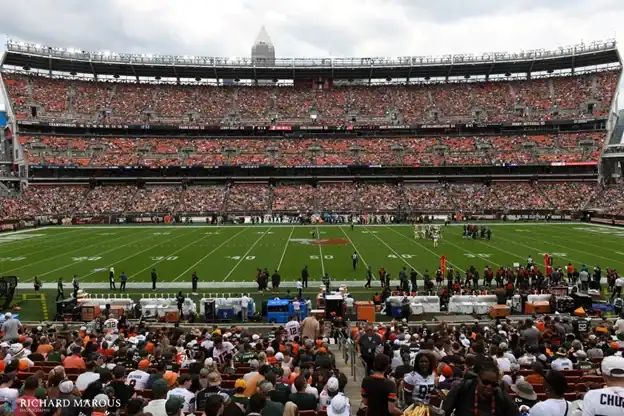Cleveland Observer
When the Cleveland Browns were reborn in 1998, civic leaders framed the team’s return as a triumph of identity and pride. Behind the celebration was one of the most expensive franchise arrangements of its era: financier Alfred Lerner’s $530 million purchase of the new Browns, with a stadium plan that prioritized premium seating and personal seat licenses. CBS News reported at the time that the price “shattered the previous record for a pro sports franchise,” and detailed revenue streams from luxury boxes, club seats and 41,000 PSLs.
What the 1998 deal promised
Lerner’s bid restored an NFL team to Cleveland after the original Browns moved to Baltimore in 1996. The football-only stadium rose on the lakefront where Municipal Stadium once stood, financed primarily through public funds and city bonds, with the team retaining key stadium revenues. Contemporary coverage emphasized the upside for the franchise and league, while noting skepticism about profitability at such a high acquisition price.
What taxpayers have paid since
A 2023 Signal Cleveland analysis found that since 1998 the city has been on the hook for roughly $350 million to build, repair and upgrade the stadium, not including opportunity costs or all interest payments tied to public debt. The public tab, the outlet concluded, is “hundreds of millions and counting.”
Those long-tail costs closely track what economists have documented nationwide: stadium subsidies frequently fall short of promised economic returns. In a 2023 policy retrospective, economists J.C. Bradbury, Dennis Coates and Brad Humphreys reviewed decades of research and found “little to no tangible economic impacts” from stadium subsidies for host communities. (That broad conclusion appears repeatedly across the peer-reviewed literature.)
Who benefited
While the team’s on-field record has fluctuated, franchise value surged. In 2012, Randy Lerner sold the Browns to Jimmy Haslam for roughly $1 billion, according to ESPN and Forbes contemporaneous reporting, underscoring how franchise valuations can climb even as public costs persist.
Supporters of the 1998 arrangement argued the team’s presence delivered intangible benefits: civic identity, national visibility and regular downtown foot traffic on game days. But academic literature cautions that much of the stadium-related spending is substitution rather than net new economic activity, meaning dollars are often shifted from other local entertainment options. Kennesaw State University+1
Dissenting perspectives (then and now)
Economists voiced doubts even in 1998. CBS News noted that “some experts doubt the Browns can be a money-making venture at such a high price,” a perspective that foreshadowed later debates over whether Cleveland’s public obligations balanced the private benefits accruing to the franchise.
Critics of stadium subsidies say the structure of such deals typically allows owners to capture most upside through premium seating, naming rights and ancillary development, while the public sector bears construction, maintenance and infrastructure risk. That critique is central to Bradbury-Coates-Humphreys’ findings and is echoed by fiscal watchdogs nationally.
Local skepticism has also grown as cumulative costs became clearer. Signal Cleveland’s accounting of hundreds of millions in obligations fed calls for tougher public-interest protections in any subsequent negotiations.
Supporters’ counterarguments
Backers of the Browns’ presence downtown have long argued that intangible benefits matter: fan cohesion, city branding, and catalytic lakefront activity around home games. They also point to the team’s willingness over time to invest in renovations and to pursue naming-rights partnerships that keep NFL visibility high. Those arguments, while difficult to quantify, remain staples of the pro-stadium case in many U.S. cities.The broader context, however, is that independent economic evaluations consistently find modest measurable returns for taxpayers relative to costs.
How the 1998 deal set the stage
The Lerner era established Cleveland’s modern stadium financing template: significant public commitments paired with private control of premium revenue. That framework, critics say, left the city paying for upkeep while the team benefited from escalating NFL media rights and venue-based income as reported by Signal Cleveland, a split that became more pronounced as franchise valuations rose into the billions.
Why this history matters now 
The historical record is newly relevant as state and local leaders weigh public investment in the Browns’ next chapter. In July 2025, Gov. Mike DeWine signed a state budget that sets aside $600 million in unclaimed-funds-backed support for a new, enclosed stadium in Brook Park, part of a project widely reported at $2.4 billion. Axios and The Statehouse News Bureau covered the budget approval and funding mechanism.
Lessons Echo in the New Deal
That loss of leverage is at the center of Cleveland’s current stadium controversy. The Browns’ owners, Haslam Sports Group, are pushing a $2.4 billion enclosed stadium project in Brook Park, backed by $600 million in state funds under the 2025 Ohio budget.
To end legal disputes and allow relocation, Mayor Justin Bibb’s administration announced a $100 million settlement with the team in October, but the City Council has pushed back hard.
Council President Blaine Griffin issued a “strict mandate” to the city’s law director not to dismiss any lawsuits related to the Browns deal without council approval, directly challenging the Mayor’s authority to finalize the settlement. Griffin told reporters he was “not fully informed” about negotiations until hours before the press conference announcing the agreement, calling it “a major communication breakdown.”
Other council members have voiced concern that the $100 million figure may be insufficient, questioning how the negotiation was conducted and what role the Browns will play in future lakefront redevelopment.
Councilman Brian Kazy compared the proposed settlement to the team’s 1995 relocation to Baltimore, saying, “We were blindsided then, and it feels like it’s happening again.” Councilman Michael Polensek said approving the settlement without full public debate would be like “giving up or taking a knee.”
Proponents argue a modern, multi-use venue could support year-round events and a broader entertainment district; opponents counter that the public share remains large and the 1998 experience shows how difficult it is to transform stadium promises into citywide economic gains.
Bottom line
The 1998 Lerner deal delivered what Cleveland most wanted, the Browns’ return, while locking in public obligations that have stretched for decades. Independent research suggests those costs rarely translate into broad economic dividends. As the region considers a new stadium era, the lessons of 1998 point to one central question for taxpayers: how to structure any agreement so that benefits are shared, risks are contained and the public’s return is real and not a pipe dream. The core debate is no longer just about sports, it’s about accountability, transparency, and whether Cleveland has learned from 1998.





